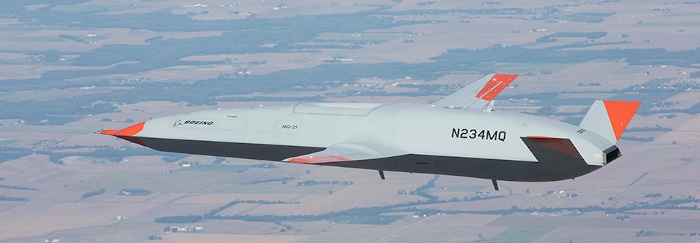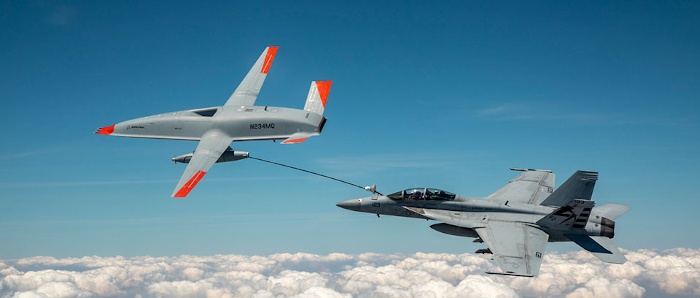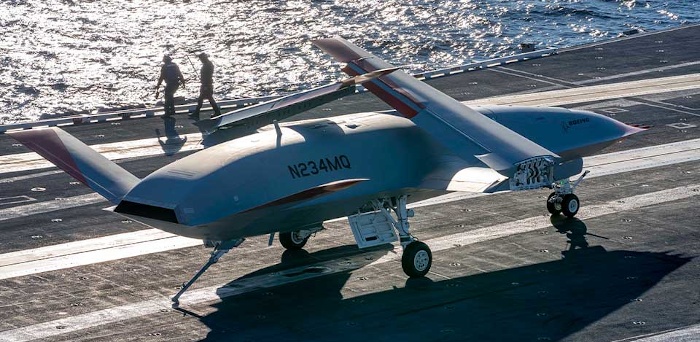Boeing MQ-25 Stingray
The MQ-25 Stingray is a carrier-based UAV with a primary aerial-refulling and a secondary ISR (Intelligence, Surveiilance and Reconnaissance) mission.
The origins of the MQ-25 lie in the Navy's UCLASS (Unmanned Carrier-Launched Airborne Surveillance and Strike) program, which was formally started in 2010 with the goal to develop a CVN-based stealthy ISR and precision strike UCAV (Unmanned Combat Aerial Vehicle). Four companies worked on competing designs for UCLASS - Northrop Grumman, Lockheed Martin, Boeing and General Atomics, each building on existing UAV designs. The designation ZRAQ-25A was assigned to the forthcoming UCLASS aircraft.
However, the program didn't run smoothly. Requirements, like the degree of steathiness, the strike payload capacity and even the aircraft's primary mission, were constantly changing. By 2013, the concept aircraft had grown so much in size and weight, that it could no longer be implemented by any of the designs being developed by the competing companies. During 2014, the concept was revised again, with more emphasis on ISR than on strike. Finally, in February 2016, it was announced that UCLASS would effectively be abandoned, and replaced by a concept named CBARS (Carrier-Based Aerial-Refueling System).
 |
| Photo: Boeing |
| MQ-25A |
CBARS called for an unmanned aerial tanker with a secondary ISR mission. Stealth requirements were significantly reduced, and strike capability was deferred to a possible later version of the aircraft. The MDS designation was changed to ZMQ-25A to reflect the new role, and the official name Stingray was assigned. An RFP with detailed requirements was issued to the four original UCLASS competitors in 2017, and in October 2018 it was announced that Boeing would receive a contract to build the MQ-25A Stingray. Boeing's bid was based on a prototype, which had been developed privately since 2014, in anticipation of shifting Navy UCAV requirements.
 |
| Photo: Boeing |
| MQ-25A |
The MQ-25A is a relatively conventional ("wing-body-tail") design, with long straight wings optimized for long endurance. It is powered by a single turbofan, and equipped with the usual assets for carrier operation, incl. a sturdy landing gear, folding wings and an arrestor hook. It is able to deliver at least 7250 kg (16000 lb) of fuel at a range of 930 km (580 miles). No further performance characteristics have been published, nor are there any details available about the ISR capabilities. The Stingray is remotely controlled by MD-5 ground-control stations, of which there will be three variants: the carrier-based MD-5C, the shore-based MD-5D and the embarkable (mobile) MD-5E.
 |
| Photo: Boeing |
| MQ-25A |
The first flight of the MQ-25A occurred in September 2019. Later milestones include the first aerial refuelling test in June 2021, and carrier deck trials in December 2021. Current Navy plans call for the acquisition of 76 MQ-25A aircraft, and an IOC (Initial Operational Capability) in 2026 with a deployment on CVN-71 Theodore Roosevelt.
Specifications
Note: Data given by several sources show slight variations. Figures given below may therefore be inaccurate!
Data for MQ-25A:
| Length | 15.5 m (51 ft) |
| Wingspan | 22.9 m (75 ft) |
| Height | 3.0 m (9.8 ft) |
| Weight | ? |
| Speed | ? |
| Ceiling | ? |
| Range | 930 km (580 miles) |
| Propulsion | 1 Rolls-Royce AE3700N turbofan; > 44 kN (10000 lb) |
Main Sources
[1] Wikipedia: Boeing MQ-25 Stingray
[2] Boeing MQ-25 Website
[3] The War Zone, Tyler Rogoway:
We Finally See The Wings On Boeing's MQ-25 Drone As Details About Its Genesis Emerge
[4] USNI News, Sam Lagrone:
MQ-25A Stingray
IOC Pushed to 2026 Following Manufacturing Delays
Back to Directory of U.S. Military Rockets and Missiles, Appendix 2
Last Updated: 20 January 2024